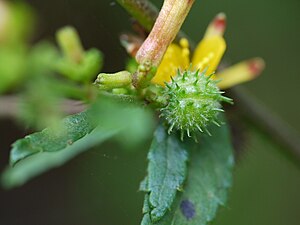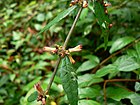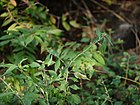Note: This is a project under development. The articles on this wiki are just being initiated and broadly incomplete. You can Help creating new pages.
Difference between revisions of "Triumfetta rhomboidea"
(Created page with "{{stub}} ==Uses== {{Uses|}}, {{Uses|}}, {{Uses|}}, {{Uses|}}, {{Uses|}}, {{Uses|}}, {{Uses|}}, {{Uses|}}, {{Uses|}}, {{Uses|}}, {{Uses|}}.<ref name="Uses"/> ==Parts Used== {{...") |
(→Identification) |
||
| (3 intermediate revisions by the same user not shown) | |||
| Line 1: | Line 1: | ||
| − | + | [[File:Triumfetta rhomboidea (5213975841).jpg|thumb|right|''Triumfetta rhomboidea'']] | |
| + | '''Paroquet bur''' is an erect shrub or perennial herb with stems that are woody at the base, growing up to 1.5 metres tall. The plant has a number of local uses - it has various medicinal applications; yields a good fibre; and has somewhat edible leaves. It was at one time cultivated in Malawi as a fibre crop. | ||
==Uses== | ==Uses== | ||
| − | {{Uses|}}, {{Uses|}}, {{Uses|}}, {{Uses|}}, {{Uses|}}, {{Uses| | + | {{Uses|Internal ulcerations}}, {{Uses|Diarrhoea}}, {{Uses|Dysentery}}, {{Uses|Internal haemorrhages}}, {{Uses|Gonorrhoea}}, {{Uses|Boils}}.<ref name="Uses"/> |
==Parts Used== | ==Parts Used== | ||
| − | {{Parts Used|}}, {{Parts Used| | + | {{Parts Used|Leaves}}, {{Parts Used|Stem}}. |
==Chemical Composition== | ==Chemical Composition== | ||
| − | <ref name="chemical composition"/> | + | Preliminary phytochemical screening of both the extracts utilizing standard methods of analysis revealed the presence of steroid, triterpenoids, glycosides, flavonoids etc.<ref name="chemical composition"/> |
==Common names== | ==Common names== | ||
| − | {{Common names|sa=|en=|gu=|hi=|kn=|ks=|ml=|mr=|pa=|ta=|te=}} | + | {{Common names|sa=Jhinjhirita|en=Burr Bush, Chinese burr|gu=Jhipato|hi=Chikti|kn=ಕಾಡುಬೆಂಡೆ Kaadu bende|ks=|ml=Oorppam|mr=Jhinjhardi|pa=|ta=Kapotam|te=Bankatuttara}}<ref name="Common names"/> |
==Properties== | ==Properties== | ||
| Line 16: | Line 17: | ||
===Dravya=== | ===Dravya=== | ||
===Rasa=== | ===Rasa=== | ||
| − | |||
===Guna=== | ===Guna=== | ||
| Line 29: | Line 29: | ||
==Habit== | ==Habit== | ||
| − | {{Habit|}} | + | {{Habit|Shrub}} |
==Identification== | ==Identification== | ||
===Leaf=== | ===Leaf=== | ||
| − | {{Leaf|||}}<ref name="Leaf"/> | + | {{Leaf|Simple|Alternate|Blade ovate to rhomboid}}<ref name="Leaf"/> |
===Flower=== | ===Flower=== | ||
| − | {{Flower||||}} | + | {{Flower|Obovate|5mm long||It is small in size|Flowering season is June-February}} |
===Fruit=== | ===Fruit=== | ||
| − | {{Fruit||||||}} | + | {{Fruit||1-1.5mm long||||Covered with 75 to 100 hooked spines, Fruiting season is June-February}} |
===Other features=== | ===Other features=== | ||
| Line 48: | Line 48: | ||
==Mode of Propagation== | ==Mode of Propagation== | ||
| − | {{Propagation|}} | + | {{Propagation|Seeds}}. |
==How to plant/cultivate== | ==How to plant/cultivate== | ||
| − | <ref name="How to plant/cultivate"/> | + | The plant produces seed capsules covered in hooked spines that adhere strongly to animal fur, clothing etc, and are thus easily transported to new sites.<ref name="How to plant/cultivate"/> |
==Commonly seen growing in areas== | ==Commonly seen growing in areas== | ||
| − | {{Commonly seen|}}, {{Commonly seen|}}, {{Commonly seen|}}, {{Commonly seen| | + | {{Commonly seen|An abundant weed along roads}}, {{Commonly seen|Waste places}}, {{Commonly seen|Thickets}}, {{Commonly seen|Canefields}}. |
==Photo Gallery== | ==Photo Gallery== | ||
<gallery class="left" caption="" widths="140px" heights="140px"> | <gallery class="left" caption="" widths="140px" heights="140px"> | ||
| − | + | "+arya+" triumfetta rhomboidea - pilangsari 2020 0.jpg | |
| + | "+arya+" triumfetta rhomboidea - pilangsari 2020 1.jpg | ||
| + | "+arya+" triumfetta rhomboidea - pilangsari 2020 2.jpg | ||
| + | 29 Triumfetta rhomboidea - John Lindley - Collectanea botanica (1821).jpg | ||
| + | Bojoramuli (in Oriya) (1391675340).jpg | ||
| + | Triumfetta rhomboidea (4124564420).jpg | ||
| + | Triumfetta rhomboidea (5213963811).jpg | ||
| + | Triumfetta rhomboidea (5213975841).jpg | ||
</gallery> | </gallery> | ||
| Line 64: | Line 71: | ||
<references> | <references> | ||
| − | <ref name="chemical composition">[ | + | <ref name="chemical composition">[https://www.rjpbcs.com/pdf/2010_1(3)/54.pdf Chemical constituents]</ref> |
| − | <ref name="Leaf"> | + | <ref name="Leaf">Kappatagudda - A Repertoire of Medicianal Plants of Gadag by Yashpal Kshirasagar and Sonal Vrishni, Page No. 378</ref> |
| + | <ref name="Common names">[http://www.flowersofindia.net/catalog/slides/Burr%20Bush.html Common names]</ref> | ||
| − | <ref name="How to plant/cultivate">[ | + | <ref name="How to plant/cultivate">[http://tropical.theferns.info/viewtropical.php?id=Triumfetta+rhomboidea Cultivation]</ref> |
<ref name="Uses">Indian Medicinal Plants by C.P.Khare</ref> | <ref name="Uses">Indian Medicinal Plants by C.P.Khare</ref> | ||
</references> | </references> | ||
==External Links== | ==External Links== | ||
| − | * [ ] | + | * [https://sites.google.com/site/efloraofindia/species/m---z/m/malvaceae/triumfetta/triumfetta-rhomboidea Triumfetta rhomboidea on sites.google.com] |
| − | * [ ] | + | * [https://www.prota4u.org/database/protav8.asp?g=pe&p=Triumfetta+rhomboidea+Jacq. Triumfetta rhomboidea on prota4u.org] |
| − | + | ||
[[Category:Herbs]] | [[Category:Herbs]] | ||
Latest revision as of 17:43, 20 May 2021
Paroquet bur is an erect shrub or perennial herb with stems that are woody at the base, growing up to 1.5 metres tall. The plant has a number of local uses - it has various medicinal applications; yields a good fibre; and has somewhat edible leaves. It was at one time cultivated in Malawi as a fibre crop.
Contents
- 1 Uses
- 2 Parts Used
- 3 Chemical Composition
- 4 Common names
- 5 Properties
- 6 Habit
- 7 Identification
- 8 List of Ayurvedic medicine in which the herb is used
- 9 Where to get the saplings
- 10 Mode of Propagation
- 11 How to plant/cultivate
- 12 Commonly seen growing in areas
- 13 Photo Gallery
- 14 References
- 15 External Links
Uses
Internal ulcerations, Diarrhoea, Dysentery, Internal haemorrhages, Gonorrhoea, Boils.[1]
Parts Used
Chemical Composition
Preliminary phytochemical screening of both the extracts utilizing standard methods of analysis revealed the presence of steroid, triterpenoids, glycosides, flavonoids etc.[2]
Common names
| Language | Common name |
|---|---|
| Kannada | ಕಾಡುಬೆಂಡೆ Kaadu bende |
| Hindi | Chikti |
| Malayalam | Oorppam |
| Tamil | Kapotam |
| Telugu | Bankatuttara |
| Marathi | Jhinjhardi |
| Gujarathi | Jhipato |
| Punjabi | |
| Kashmiri | |
| Sanskrit | Jhinjhirita |
| English | Burr Bush, Chinese burr |
Properties
Reference: Dravya - Substance, Rasa - Taste, Guna - Qualities, Veerya - Potency, Vipaka - Post-digesion effect, Karma - Pharmacological activity, Prabhava - Therepeutics.
Dravya
Rasa
Guna
Veerya
Vipaka
Karma
Prabhava
Habit
Identification
Leaf
| Kind | Shape | Feature |
|---|---|---|
| Simple | Alternate | Blade ovate to rhomboid |
Flower
| Type | Size | Color and composition | Stamen | More information |
|---|---|---|---|---|
| Obovate | 5mm long | It is small in size | Flowering season is June-February |
Fruit
| Type | Size | Mass | Appearance | Seeds | More information |
|---|---|---|---|---|---|
| 1-1.5mm long | Covered with 75 to 100 hooked spines, Fruiting season is June-February |
Other features
List of Ayurvedic medicine in which the herb is used
Where to get the saplings
Mode of Propagation
How to plant/cultivate
The plant produces seed capsules covered in hooked spines that adhere strongly to animal fur, clothing etc, and are thus easily transported to new sites.[5]
Commonly seen growing in areas
An abundant weed along roads, Waste places, Thickets, Canefields.
Photo Gallery
References
- ↑ Indian Medicinal Plants by C.P.Khare
- ↑ Chemical constituents
- ↑ Common names
- ↑ Kappatagudda - A Repertoire of Medicianal Plants of Gadag by Yashpal Kshirasagar and Sonal Vrishni, Page No. 378
- ↑ Cultivation
External Links
- Ayurvedic Herbs known to be helpful to treat Internal ulcerations
- Ayurvedic Herbs known to be helpful to treat Diarrhoea
- Ayurvedic Herbs known to be helpful to treat Dysentery
- Ayurvedic Herbs known to be helpful to treat Internal haemorrhages
- Ayurvedic Herbs known to be helpful to treat Gonorrhoea
- Ayurvedic Herbs known to be helpful to treat Boils
- Herbs with Leaves used in medicine
- Herbs with Stem used in medicine
- Herbs with common name in Kannada
- Herbs with common name in Hindi
- Herbs with common name in Malayalam
- Herbs with common name in Tamil
- Herbs with common name in Telugu
- Herbs with common name in Marathi
- Herbs with common name in Gujarathi
- Herbs with common name in Sanskrit
- Herbs with common name in English
- Habit - Shrub
- Index of Plants which can be propagated by Seeds
- Herbs that are commonly seen in the region of An abundant weed along roads
- Herbs that are commonly seen in the region of Waste places
- Herbs that are commonly seen in the region of Thickets
- Herbs that are commonly seen in the region of Canefields
- Herbs








